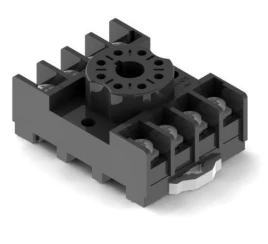Understanding 8 Pin Octal Relay Socket: A Comprehensive Guide

Relays are used to establish and break electrical connections in circuits of many electrical components and systems. These electrical devices can transform the movement of an electromagnet into the activation of physical switches deep behind the device. This switching mechanism enables them to control the high-power circuits with the low-power signals, which gives them tremendous advantage for widespread usage.
8 Pin Octal Relay Sockets
The 8 pin octal relay socket is the most common type of socket in the market. Its standard configuration meets the needs of a wide range of general-purpose relays. The most common function of these relay sockets is to handle control signals and switch functions of the electronic circuits.
The typical pin functions in an 8 pin octal relay socket-
- Pins 1 & 8: These pins carry the current that energizes the electromagnet of the relay, thus aiding in the opening or closing of the internal switch.
- Pins 2 & 7: Pins are used to link to the circuit you want to control. The common pin signifies the positions of the switch, whether it’s activated or not.
- Pins 3 & 6: It may differ from relay to relay – for example, some relays have extra pins that are used for signal management like a diode across the coil to prevent surges or an LED to indicate status.
The simple and economical 8 pin octal relay socket is suitable for all kinds of applications. They are the most common in industrial control systems building automation and security systems, robotics and automation projects, Audio/video equipment, and measurement equipment.
How Does an 8 Pin Octal Relay Socket Work?
- Pin Configuration: The relay has an eight-pin socket, every pin represents some particular operation of the relay. These pins are used to make connections with the electrical circuit where the relay is used. These pins are arranged to suit different relays in the market for proper compatibility.
- Relay Insertion: The relay is plugged into the socket through the alignment of the pins to the holes present in the socket. After being placed in the circuit, the relay establishes a connection with the circuit through the pins.
- Securing the Relay: The relay is firmly fixed in the socket so that it does not come out or disconnect. Such a connection is critical in ensuring the effective working of the relay in the circuit.
- Ease of Replacement: The other benefit that can be associated with the use of the 8 Pin Octal Relay Socket is the ease of replacing the relays. Removing the relay from the socket is easy and you can replace it with a new one without necessarily requiring wiring.
- Electrical Connection: When the relay is activated then current passes through the pins required hence effective completion of the electrical circuit. This socket also assists in the orientation of the relay so that the electrical connections are well-established while mounting.
Importance of 8 pin Octal Relay Socket
Industrial Automation: In industries and production plants, relays are used to control the ON and OFF of machines and equipment. The 8 Pin Octal Relay Socket is used for holding relays for motors, and lights among other devices that are used in a control panel.
Power Distribution: The 8 pin octal relay sockets perform key monitoring and protection functions in the power distribution and the electrical infrastructure. These sockets are important mounting points for relay applications, and they include circuit breakers, motor starters, and overload protection devices.
HVAC Systems: HVAC relays help in controlling the fans, compressor, and all the similar apparatuses for heating, ventilation, and air conditioning systems. The 8 Pin Octal Relay Socket is normally designed to be used in the control section of such systems.
Telecommunications: In telecom systems, relays are employed either for switching or for controlling the flow of the controlling gear. The eight-pin socket provides a good hold on these relays, and it is very convenient to replace them if they are faulty.
Building Automation: Among the facilities that are installed in the new generation of buildings through the automation systems are lighting, security, and climate control. These systems use relays, and the 8 Pin Octal Relay Socket is one of the connectors fitted on the panel.
Selecting the Right 8 Pin Octal Relay Socket
Relay Compatibility: Make sure that the pin configuration of the socket matches the relay that you would like to use.
Current Rating: Choose a socket that will have an ampere value higher than the maximum current you will be pulling in your relay.
Safety Systems: Safety comes first in industrial settings. The 8-pin octal relay sockets play a key role in safety circuits. These sockets help add relays for ESD, fire, and gas systems.
Conclusion
The 8 Pin Octal Relay Socket is one of the most used interfaces in almost any electrical system and device. Due to its general type, simplicity, and flexibility of use and installation, it can be used in most areas such as industrial and automobile.
Thus, knowing the way this socket is arranged and what parameters have to be taken into consideration when choosing it will help connect the relays properly, which will improve the working and greater durability of the electric networks.
If you work with electrical connections and circuits—as an electrician, engineer, or in any other role—you should have an 8 pin Relay Socket in your toolkit!
